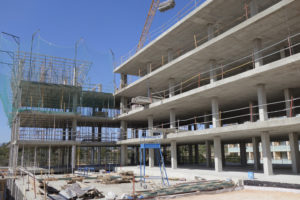Building owners and real estate investors use cost segregation studies to lower their tax bills and increase their current cash flow.
These studies divide your real estate into components to accelerate allowable depreciation deductions and save you tax dollars today. Dollars that you can put back into growing your business or use in other investments.
On average, 20% to 40% of real estate components will be reclassified into tax class lives that are written off significantly quicker than the building structure. This can result in a substantially lower tax liability.

If 30% of the property was reclassified from 39-years to 15-years and 5-years would have a year one additional deduction of $1,500,000 with an after-tax present value benefit of $600,000 with a 10-year NPV benefit of $480,000.
Here’s what you need to consider when deciding to pursue a cost segregation study.
What types of real estate are eligible?
Cost segregation works on acquired, newly constructed, expanded, remodeled or build-outs of commercial and residential income properties.
This process does not have to occur in the year the event happened. An owner can “look back” to when a building owner originally purchased or built a building to take all the depreciation allowed but not claimed. This will not require an amended tax return, but simply filing one form 3115 change in accounting method.
Why cost segregation study?
The IRS mandates a building’s costs be depreciated over 39 years (27.5 for residential income properties).
A qualified tax professional will dissect and recommend reclassifying some of your building’s costs into shorter depreciation lives to 15, 7, or 5 years.
What to expect from a qualified tax professional in an engineering-based study:
- Work with you to gather basic property information to analyze your tax situation
- Prepare a projected benefit analysis of the expected accelerated depreciation with an estimate of the net present value of the tax benefits
- Collect final cost, construction drawings, and/or a purchase agreement depending on the project type
- Visit the site to verify existence and review condition of real estate components
- Document conditions with photos and other records
- Prepare and deliver a final report to you
What specifically does a cost segregation study segregate out?
Most of a building’s components are normally depreciated over 39 years for commercial and 27.5 years for residential.
A cost segregation study will try to shift eligible personal property items into a 5- or 7-year bucket and land improvement items into a 15-year bucket.
What counts as personal property? Typically, it’s items that you can move, such as appliances, but it also includes such items as specialty flooring and decorative wall coverings along with built-in cabinetry.
Land improvements are exterior items such as paving, retaining walls and landscaping.
Long-term value of cost segregation study

Before the Tax Cut and Jobs Act in 2017, losses were not allowed for retired building components; and, consequently, the replacement of building components resulted in the continued depreciation of both the replaced and replacement property.
But under current tax law, improvements are a deductible repair or a capital expense.
The impact of Tax Cuts and Jobs Act
Since deduction depreciation was first added to Section 168 of the Internal Revenue Code, at least 12 laws have passed that enhance or extend depreciation allowances, including the Tax Cuts and Jobs Act in December 2017.
Here is an overview:
Bonus Depreciation: Bonus depreciation went from 50% to 100%, which means you can take an immediate write-off of the entire asset with a depreciation period of 20 years or less.
For property acquired AND placed-in-service after September 27, 2017, the following schedule applies:
- September 27, 2017-December 31, 2022 – 100% bonus
- January 1, 2023-December 31, 2023 – 80% bonus
- January 1, 2024-December 31, 2024 – 60% bonus
- January 1, 2025-December 31, 2025 – 40% bonus
- January 1, 2026-December 31, 2026 – 20% bonus
Also, bonus depreciation also now applies to both newly constructed buildings as well as acquisitions of used property acquired after September 27, 2017, for real property with a class life of 20-years or less.
Qualified Improvement Property (QIP): Qualified leasehold improvements, qualified restaurant improvements and qualified retail improvements are now in a general grouping of qualified improvement property.
Qualified improvement property used to involve a 39-year depreciation period and a 50% bonus. But in 2018 QIP no longer qualifies for bonus depreciation but retains its 39-year depreciation period.
It is widely agreed that removing the bonus was an unintentional oversight. Fixing it, however, will require legislative action, which takes time.
The technical correction is underway, but there’s no guarantee it will make it through Congress.
Section 179 deduction: Previously, the expense limitation was $500,000 with the phase-out limitation of $2 million. The expense limitation is now increased to $1 million with the phase-out limitation of $2.5 million.

The property that would be eligible for a Section 179 deduction would be HVAC, Fire Protection and alarms, security systems and roofs.
You can expense these items if the improvements are made to nonresidential property and added after the building was first placed in service.
Section 179 also now includes more tangible personal property used in hotels, apartments and student housing.
The IRS and Cost Segregation Studies
A study alone will not substantially increase your audit susceptibility.
A property placed in service during a prior year (commonly known as a look-back analysis), you will need to file form 3115 change in accounting method, which may be reviewed by an IRS committee but has shown not to inherently increase your audit risk.
Historically, the IRS has kept an eye out for aggressive depreciation deductions. Since the Tax Cuts and Jobs Act expanded the benefits, it’s likely you’ll see even more challenges.
In 2004, the IRS issued an Audit Techniques Guide to help agents examine the validity of depreciation deductions.
The guide, which spans 115 pages, includes:
- Industry-specific guides with unique issues, terminology and business practices
- What should IRS agents review when examining these studies?
- When do issues need further examination?
The guide was developed by a team of tax professionals and IRS agents. Even though it isn’t considered an official IRS document, it can be helpful in providing insight into which depreciation deductions will raise red flags with the IRS.
If done properly, there is no evidence that including a cost segregation study will increase the likelihood of an audit. In general, IRS agents want to make sure you’ve followed all the proper procedures in your cost segregation analysis.
Ensuring your study is prepared by a qualified professional who is using the right methodologies will help lower your risk.
Author: Steven Barnes, Senior Manager, Cost Segregation
Steve is the leader of Wipfli’s cost segregation team with expertise in the engineering approach of cost segregation for both new construction projects and purchased properties. His understanding of construction finances and his ability to analyze construction documents are important assets in the process of cost segregation projects. Steve’s experience also includes Section 263A repair versus capitalization review tangible property studies and Section 168 fixed asset disposal studies.
Steve has years of experience adjusting the timing of deductions to provide clients with tax savings. Prior to joining Wipfli, he helped lead a cost segregation practice at a regional CPA firm. Steve specializes in various industries including commercial real estate, hotel and convention, retail and wholesale, manufacturing, food processing, health care, residential and auto dealerships.
* Benefits have been calculated assuming current utilization of any losses that may be generated, using a combined effective federal and state tax rate of 32% and a discount rate of 6%.
Learn more about Steve at: https://www.wipfli.com/about-wipfli/partners-and-associates/barnes-steven
Interested in speaking with a representative in the Missoula &/or Northwest Region?
Contact Dick Shull or Jennifer Clark – or visit www.wipfli.com to find a consultant near you.




